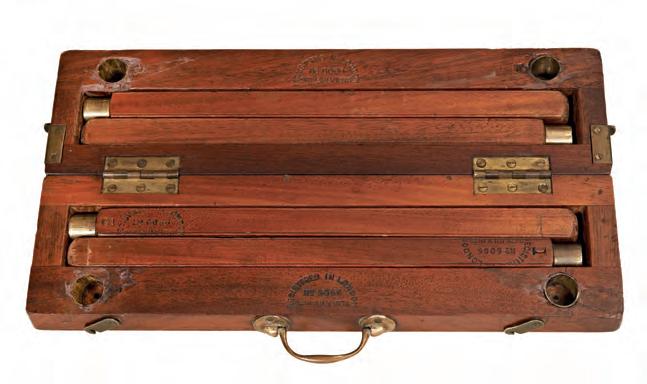
22 minute read
be better known
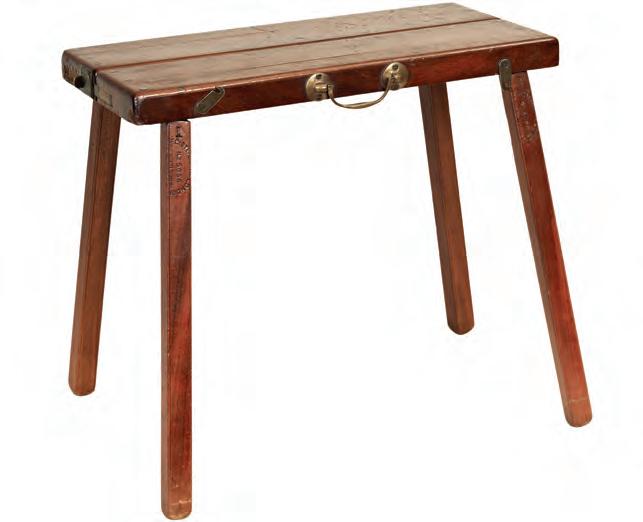
Carry on CAMPAIGNING
Designed to withstand the rigours of travel and battle at the height of the British Empire, campaign furniture remains in demand today for its flexibility, history and pared-back style
Above A mahogany, portable camp stool by Charles Green of London. Priced £650 at Christopher Clarke Antiques
Below The underside of the two-part, hinged seat of the stool has recesses to fit the four legs once removed
Left A mahogany secretaire campaign chest by S W Silver & Co
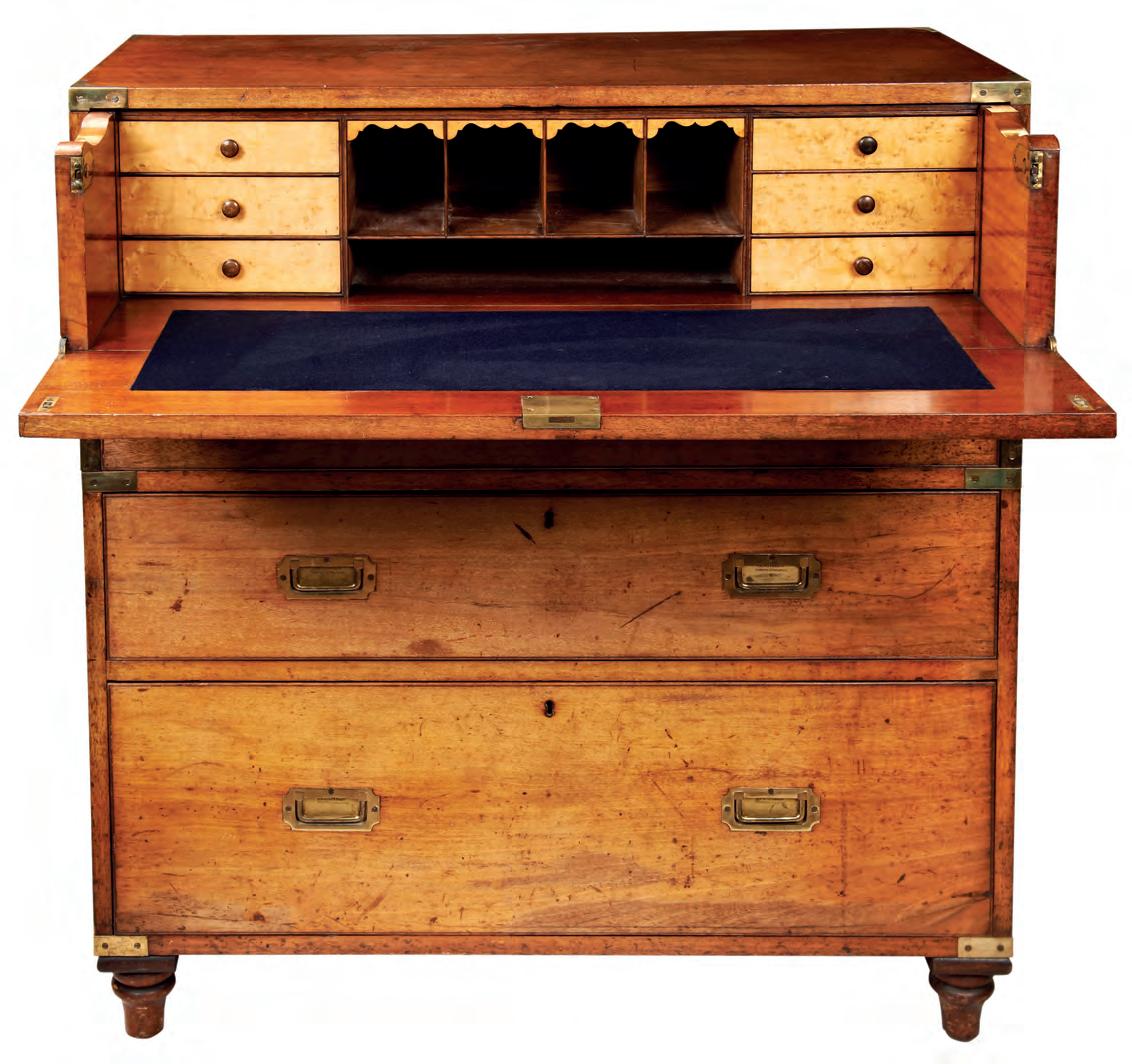
When an officer and gentleman in the Georgian and Victorian era took up an overseas commission for some remote quarter of the sprawling British Empire, he prepared to leave behind the sumptuous comforts of the family stately pile or elegant urban townhouse.
However, rather than facing the prospect of roughing it ‘under canvas’ during the weeks or months of arduous journey to foreign climes, he set off with an inbred determination that, first and foremost, he remained a gentleman, and then, secondly, a soldier.
It was an approach that saw these doughty imperialists take with them ingenious versions of the trappings and luxuries of their domestic settings, in the form of speciallydesigned, portable campaign furniture and a variety of other clever metamorphic objects. Similarly, any ladies bound for the colonies would require all manner of furniture, encompassing desks, sofas, beds and chests, all crafted by the leading makers of the day, including such luminaries as Thomas Chippendale and Sheraton, George Hepplewhite, William Ince and John Mayhew.
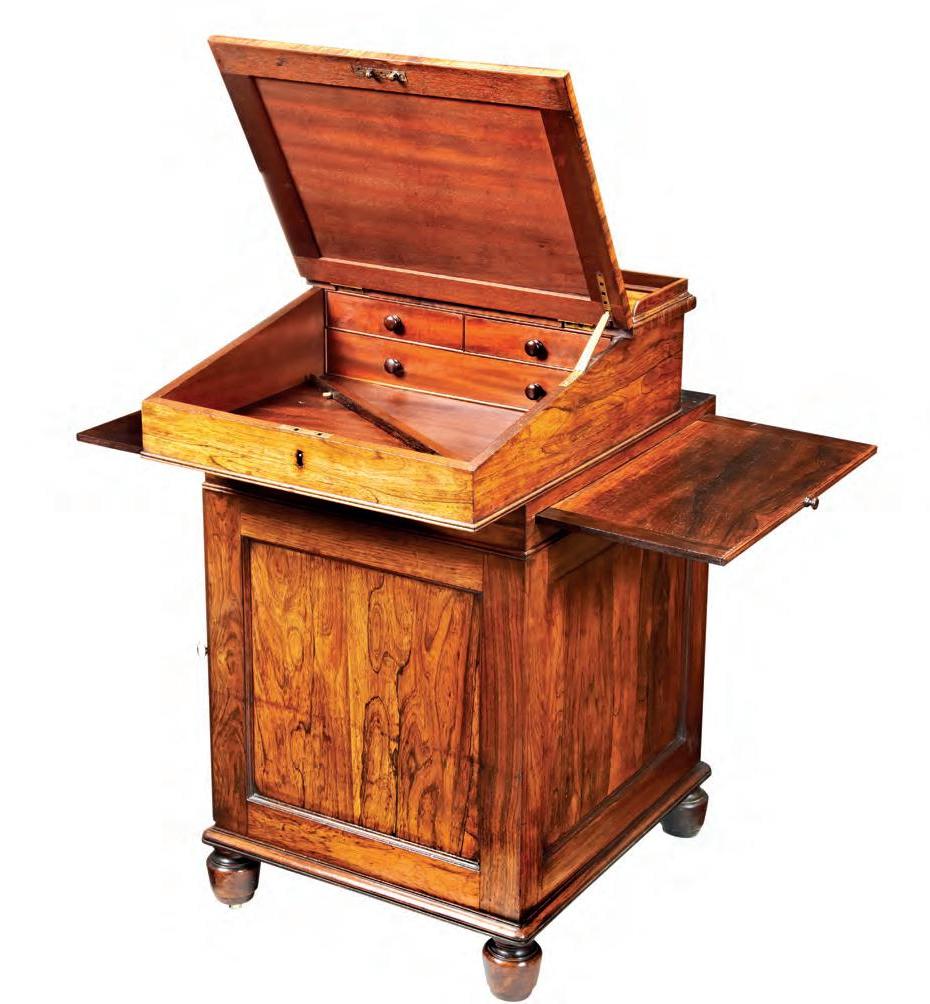
Left A rosewood davenport. The original design was conceived by Gillows as a piece of portable furniture for Captain Davenport. Priced £3,650 at Christopher Clarke Antiques
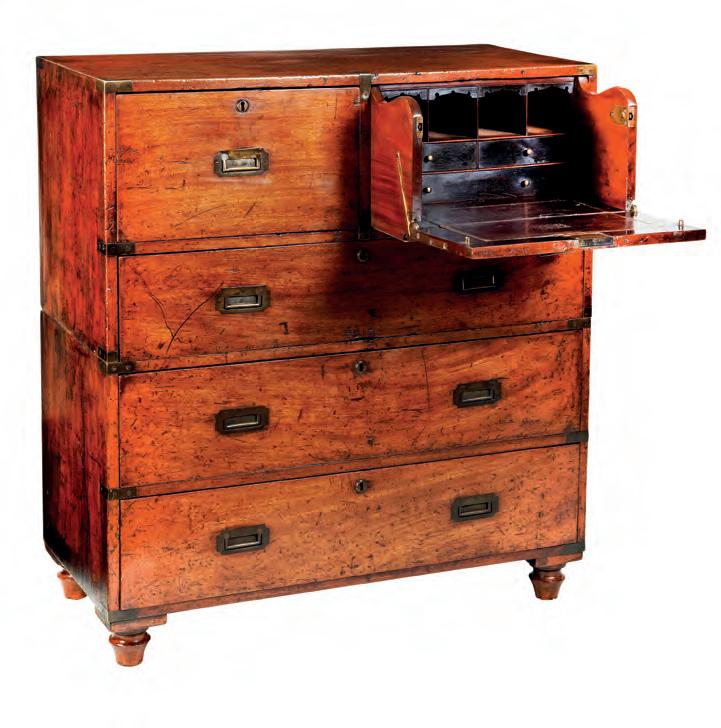
IN DEMAND
By the Victorian period, with the Empire continuing to expand, so, too, did demand for campaign furniture. No longer limited to just aristocratic officers, items became increasingly affordable to the countless army of mid-level officers, district administrators and their families.
It is estimated that more than 80 makers set up shop in the capital and the surrounding area to meet the burgeoning need. Furniture businesses and workshops such as the Army & Navy Co-operative Society Ltd., London, S.W.Silver & Co., Gregory Kane of Dublin and Ross & Co., produced all manner of furniture and fixtures to guarantee home-from-home comfort.
Moreover, as the cabins on board the ocean-going ships that took travellers to their destinations were unfitted, it provided lucrative opportunities for cabin fitters to construct items needed for the journey.
FLAT PACK
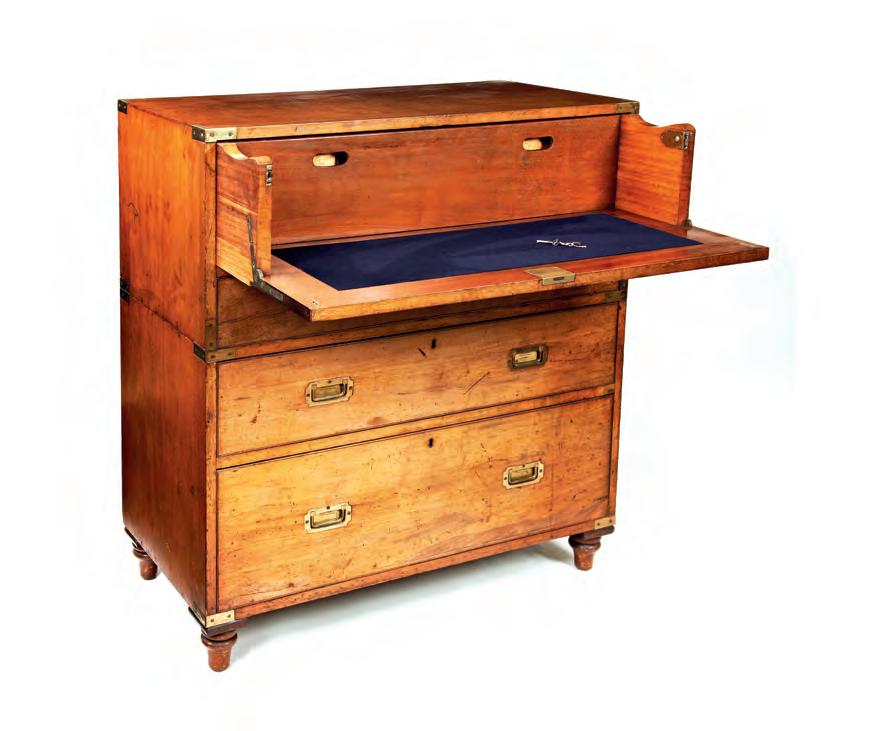
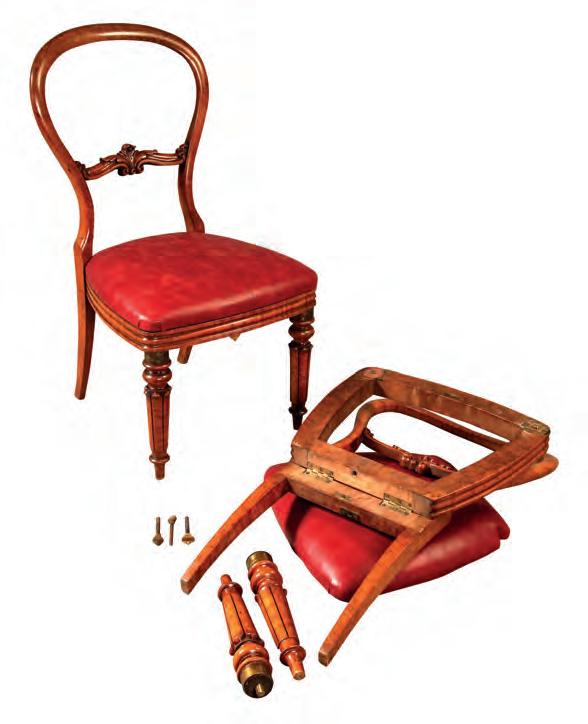
Centuries before the Swede Ingvar Kampard left behind farm life to find furniture success with Ikea, ‘flat-pack’ furniture had a well-established history. Some of the earliest historical incarnations include accounts that Julius Caesar carried parquets of wooden mosaics for his floors. However, it was the aristocratic Georgians, Victorians and, latterly, the Edwardians who popularised the campaign furniture that we recognise today. The various hallmarks and characteristics of this unique furniture genre range from protective brass plates on corners and edges, flush carrying handles, strapworks, hinged sections, X-shape legs, the relative lack of decorative ornamentation and, of course, the fact that it can be broken down or folded for transportation. However, the need for portability was not
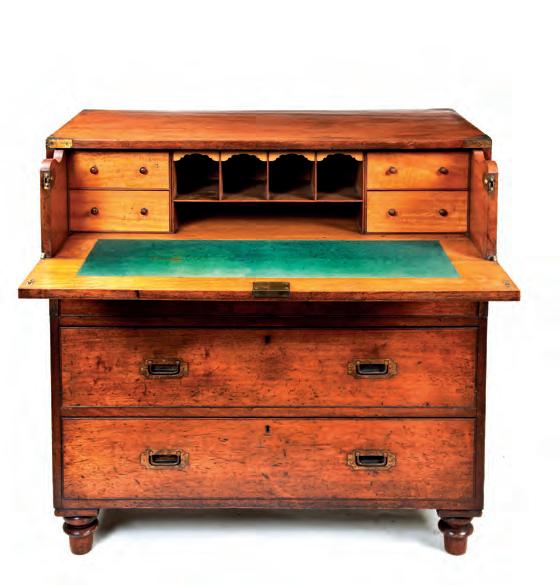
Above left A mahogany secretaire campaign chest by S W Silver, with a full-length desk drawer. Priced £3,650 at Christopher Clarke Antiques
Left A pair of bird’s eye maple, balloon back chairs that dismantle and fold down for transportation. Priced £750 at Christopher Clarke Antiques
Right A mahogany military secretaire twopart chest by makers S W Silver. Priced £3,750 at Christopher Clarke Antiques necessarily translated into the materials used for their construction (often heavy mahogany and teak).
The 19th-century scientist and travel writer Sir Francis Galton recounts in his The Art of Travel (1893) how ‘The luxuries and elegances practicable in tentlife are only limited by the means of transport’. As such, it wasn’t unknown for all manner of servants, horses, baggage camels and even elephants to be drafted in to the service of transporting items from camp to camp throughout a journey. There’s little doubt that they were needed, as The Times reported in 1858 how Sir Colin Campbell’s various baggage ‘extended for eighteen miles, when it came down from Lucknow’.
TRAVEL IN STYLE
Such extensive lists of ‘essential’ travel items were less commonplace in the Georgian era, when acquiring good examples of campaign furniture was relatively costly, making it largely the preserve of the wealthy elite. The period also gave rise to some of the grandest pieces made, courtesy of cheap labour available in the colonies, coupled with the determination of designers to create new technological innovations, vying to craft furniture boasting ever more adjustable, movable and retractable parts.
The writer Stanley Northcote-Bane recounts how ‘cabinets were often specially equipped with sliding, adjustable or disappearing mirrors; folding or swivelling candle brackets; specially equipped drawers for the toilet or for shaving; writing slides; adjustable reading flaps, etc’.
Chippendale’s Gentleman and Cabinet-Maker’s Director of 1762 boasts no less than six designs for beds constructed for the field. Similarly, in the early 19th century, Thomas Sheraton’s The Cabinet Dictionary of 1803 highlights how the designs also took into account the environment they would be used in: ‘Hence every article of an absolute necessary kind, must be made very portable, both for package, and that such utensils may not retard a rapid
movement, either after or from the enemy.’
Alongside these celebrated names, numerous other less-known makers, such as Thomas Butler, Morgan and Sanders (who were commissioned by Lord Nelson to create portable furniture for his cabin on HMS Victory), and William Pocock were also kept busy constructing campaign furniture that allowed their customers to clearly communicate their place in the social pecking order, wherever they were.
One advertisement for a portable dining table proclaimed how it could ‘form an elegant Piece for Furniture for a Dining Room…And yet be made so portable as to go with the Baggage of a Regiment for the Officers’ Mess’.
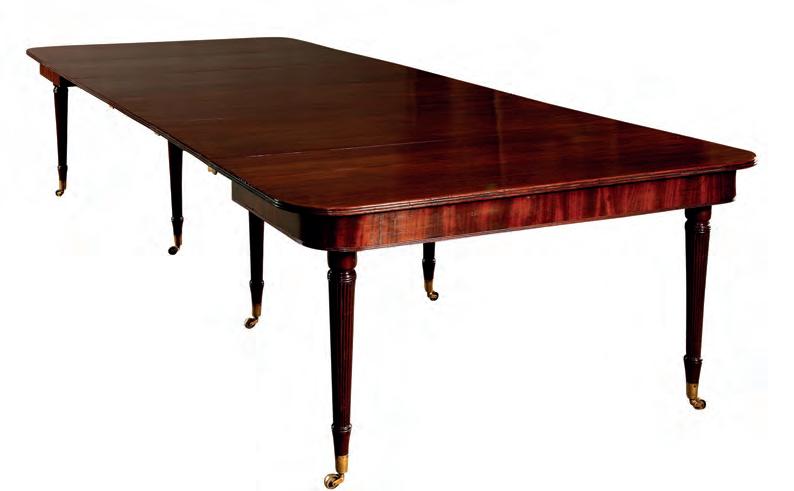
TREASURED CHESTS
Perhaps the item mostly closely associated with campaign furniture of the era is the chest of drawers. Their combination of practicality and flexibility made them extremely useful items both during the outbound journey and on eventual arrival. The most ubiquitous example is the two-part, brass bound chest. These
Above A large, mahogany extending imperial dining table by Gillows. Priced £16,500 at Christopher Clarke Antiques
Below left The chair folds into a bed, which would have had a hinged canopy to create a tent bed
Below right A mahogany chair bed design by London maker Thomas Butler, whose brass plaque is fixed to the front. Priced £4,450 at Christopher Clarke Antiques
FLEX APPEAL
Today, collectors and buyers of campaign furniture can be drawn to the items for various reasons, from their pared-back designs, to the stories that can come attached to a particular piece. Some still retain the maker’s name and address labelled or stencilled to the furniture, or brass plaques bearing the original owner’s name and rank. With a little research, a vivid picture soon emerges to tell the life of the item and its owner.
Other indicators of a chest’s history and construction can be revealed by the types of wood on the interiors, with oak and ash used by many British makers. Locks can also carry their maker’s mark and even reveal the period they were made with a ‘GR’ for the Georgian era and ‘VR’ for Victorian. However, due to their age and use, some of these components could have been replaced or repaired so are no longer original.
Changes to modern warfare - especially the three-year Boer War starting in 1902 where the Boers demonstrated the effectiveness of speed of movement -signalled the demise of campaign furniture. However, its impact is seen in the works of later designers, such as Marcel Breuer’s Wassily chair, which was inspired by the ‘Roorkhee’ chair, used by British Army Engineers in India, alongside pieces by Knoll and the Conrad shop. And, not least of all, a certain Swedish global furniture brand.
were generally transported inside a wooden packing case, and could also be split into two equal parts, which made them convenient for transportation by horse or mule. Once again, it was the wealthy customers who demanded the most technologically ingenious and beautifully-designed articles. The Army and Navy Cooperative Society’s general price list of 1881 includes a ‘Chest of Calvary Drawers with escritoire, secret drawer, and back with shelves, looking glass and fittings’.

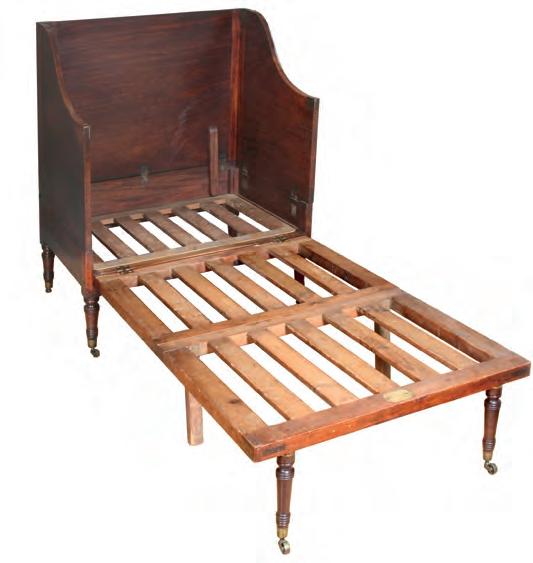
Campaign Furniture &AQ
Simon Clarke is a specialist in military campaign furniture and travel-related items, and runs Christopher Clarke Antiques in Stow-on-the Wold
QDescribe campaign furniture?
AFurniture that has been designed in such a way to make it easier to transport. This could be by officers in the military, hence the name campaign, but also others traveling around the British Empire. References can be found worldwide going back to the earliest years of civilisation, though nowadays when referring to campaign furniture we think of items used by the British from the mid-18th century to the early 20th century.
QWhat are the common features?
AThey needed to be easy to transport so you will find chest of drawers can be split in two, with removable feet. Chairs may fold flat or have removable legs and arms. Tables may also fold flat or have removable legs. Brass ferrules to the tops of legs will suggest they unscrew.
From the 18th century into the early 19th century, pieces appear much like their domestic equivalent having handles and fashionable decorative features.
The way they dismantle may be more disguised. As we move on into the 19th century, chests have brass corners and strapwork to protect them, screw-in feet and are more linear in shape. This type of 19th- century military or campaign chest is the look people think of as campaign furniture.
QWhich are the main makers?
AAt the beginning of the 19th century, with the more Georgianlooking pieces, collectors look out for two firms based in Catherine Street, London: Thomas Butler and also Morgan & Sanders – both two of the main makers.
Later in the century, the names of Ross & Co., Hill & Millard and S.W.Silver & Co., are sought after names, as well as pieces supplied by the Army & Navy Co-operative Society Ltd. However, there are also several other good makers whose work is desirable. Collectors also look to different regiments, wars, periods and countries such as the Crimea or the British in India.
QWhat dictates value?
APrimarily, the quality of construction, materials, and design. Also, clever, innovative design. These points will be further elevated by a good cabinetmaker and further still if there is a solid provenance to its owner and their importance. The better known they were the higher the price. Equally, if they fought in a particular battle, such as Waterloo or Trafalgar, value will increase. Condition and any restoration will also have a bearing.
QHow do designs differ?
AIn the second half of the 19th century, the main London makers all offered similar items with the opportunity to buy a complete outfit.
Most examples of military chests of this period follow a formulaic design. The handles, brass corners and strapwork all look the same but, on further inspection, you will find they all differ slightly. To the trained eye minor design changes may indicate a particular maker.
Some designers favoured certain drawer or strapwork configurations and many had a distinctive design for their screw-in feet.
The other area of difference may be the design of a secretaire drawer, or where the maker has hidden a secret drawer (if there is one). These little idiosyncrasies set these makers apart. Overall quality will always set one piece over another.
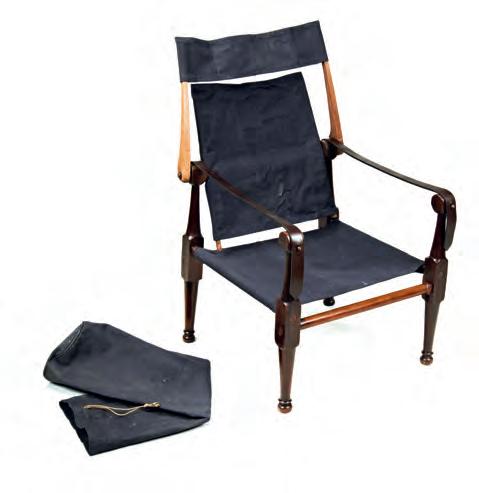
Left A teak ‘Roorkhee’ chair, unusual for having a head rest. On sale at Christopher Clarke Antiques for £390
QHow do you establish provenance?
AThis can be tricky, so to make a difference on price or collectability it needs to be solidly put together. Pieces may have a family legend that it belonged to so-and-so who was at whichever battle. This can very easily get muddled over time. Ideally, you have the piece’s packing case with the name and regiment of the owner – but make sure that the packing case belongs with the piece.
Other items may have the owner’s name on the back boards. Some trunks or chests will have a brass plaque with whom it belonged to on it, or may have a shipping label with those details.
Very occasionally you will see a painting or photograph of the owner next to the piece. Once you have the owner’s name you can research their history through relevant army lists, etc.
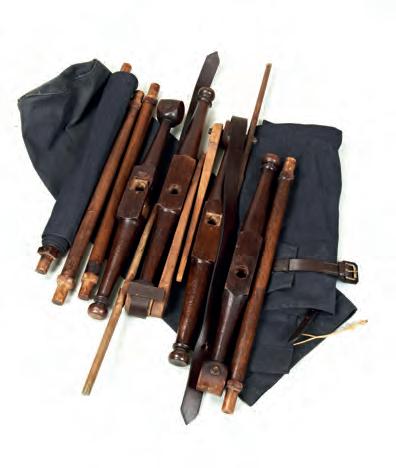
QHow do you identify genuine pieces?
AExperience, as well as talking to and buying from a knowledgeable dealer. There are some pointers that may help the beginner: Firstly, how old is it? Many pieces were made later in the 20th century that look the part, but are not genuine. Secondly, has it been adapted to look like a
campaign piece? It could be a chest or desk that has had the handles replaced, and brass strapwork and carrying handles added. This could be a chest of drawers that is a single piece, not two halves, but still has its original bracket feet.
Thirdly, look to see if it has been enhanced in any way. It may have had carrying handles added in the mistaken belief they belonged. Most British chests did not have handles to the sides as they were boxed in packing cases with handles for carrying.
Also, be sure that if a piece of furniture has an owner’s or maker’s name it is original. We have seen spurious names added to enhance value. Campaign furniture can be a minefield, so tread carefully.
QWhat are the key things buyers should consider?
AIs the piece genuine and what it has been described as? Is its condition acceptable and has it had any restoration? Is it functional? You may think you have bought a bargain but then find that the drawers on a chest don’t open smoothly, the feet are missing and you have to spend the same amount again on restoration.
QWhat ‘Holy Grail’ items would you love to acquire?
AI would love to find trade catalogues for some of the top makers as this would increase our knowledge and understanding. Regarding furniture, it would have to be a chest owned by Admiral Nelson. In fact, any piece of furniture he owned would do. Similarly any piece belonging to General Wolfe when he was in Quebec.
Also on the wish-list would be a good 19th-century piece by a great maker with a good provenance. For me and many others handling something with a great provenance makes history come to life. When you have a piece (which we have had) you can prove had been at the Battle of Waterloo it is the most incredible feeling.
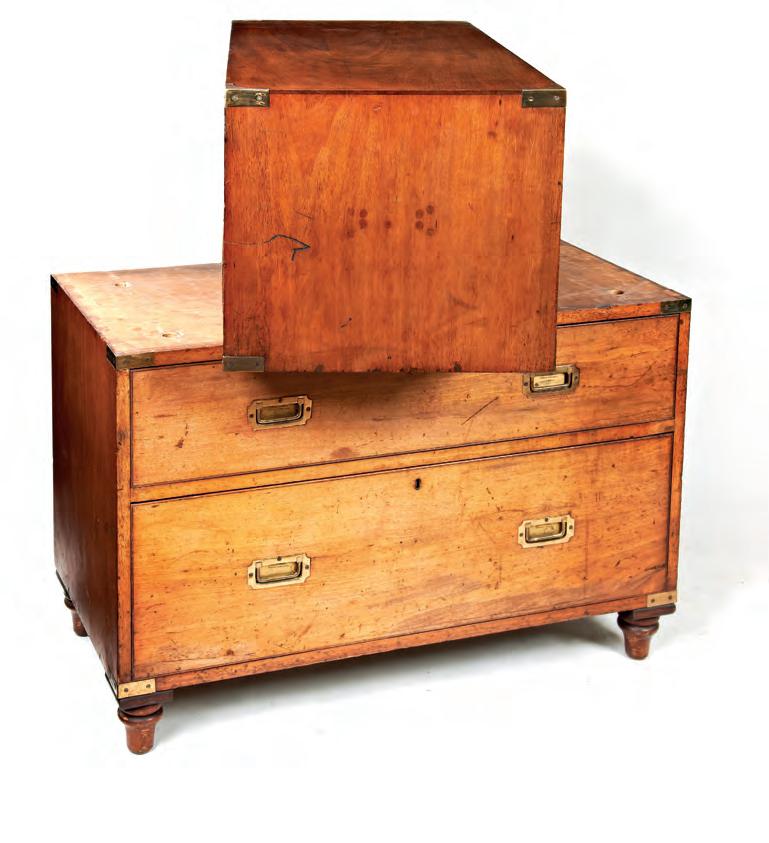
QWhat’s the most ingenious piece you’ve owned?
AAn 18th-century three-part Sheraton cylinder bureau bookcase on screwin legs. It was veneered all around in exotic timbers and made to the highest standard. It would have been unusual as a domestic piece, but as a campaign design incredibly rare.
QWhich items are currently in demand?
AThe iconic brass-bound campaign chest, as well as folding bookcases, pedestal desks and sets of chairs.
QWho is your favourite designer?
AThomas Butler of Catherine Street in London for the following
Right This chest, from the second half of the 19th century, can be broken into two parts
‘A folding chair might be used by a soldier in Sudan and then be equally useful to take to a cricket match. Many of the designs are still in use today
reasons. Before him there were designers, including Chippendale, Sheraton and Gillows, who were all instrumental in exploring designs of furniture that could be easily transported. While this signalled the start of campaign furniture, what Thomas Butler did was specialise in, and later advertise, designs and patents purely as travel furniture.
He set the bar for the many that followed, including the better-known Morgan & Sanders (who worked for him), as well as other more famous makers.
I would also mention another of our favourite makers, Ross & Co of Dublin, who not only produced a prolific amount of campaign furniture of the highest design and manufacture, but also – where possible – followed the latest fashions of the day.
QWhat is campaign furniture’s appeal?
ABrass strapwork and handles on mahogany or teak is a great look that many people like. A lot of campaign furniture is very linear in appearance with little decoration, which lends itself to both old or modern interiors. The trend for younger buyers is away from more traditional styles towards more minimalist settings that campaign furniture sits comfortably within, while having a great story to tell. It’s also easy to move around while being much more desirable than modern badly- constructed, flat-pack alternatives with very little residual value once put together. Antiques are also greener than buying new furniture.
QHow does campaign furniture differ from tourist travel furniture?
AMostly there are no great differences. Both 18th and 19th-century furniture would have fulfilled the same function for both military men or colonialists.
Before the golden age of the ocean liner you would pay for an empty cabin on board ship and then have a cabin fitter provide you with furniture and the necessities to make your journey more comfortable whether you were in the military or a civilian.
Victorian makers went on to market their portable furniture to the military and domestic markets. A folding chair a soldier might use in Sudan was equally useful at a cricket match. Many of the designs are still in use today.
Simon Clarke and his brother Sean took over the Gloucestershire-based business Christopher Clarke Antiques, founded in 1961 by their parents. For more details visit www.campaignfurniture.com
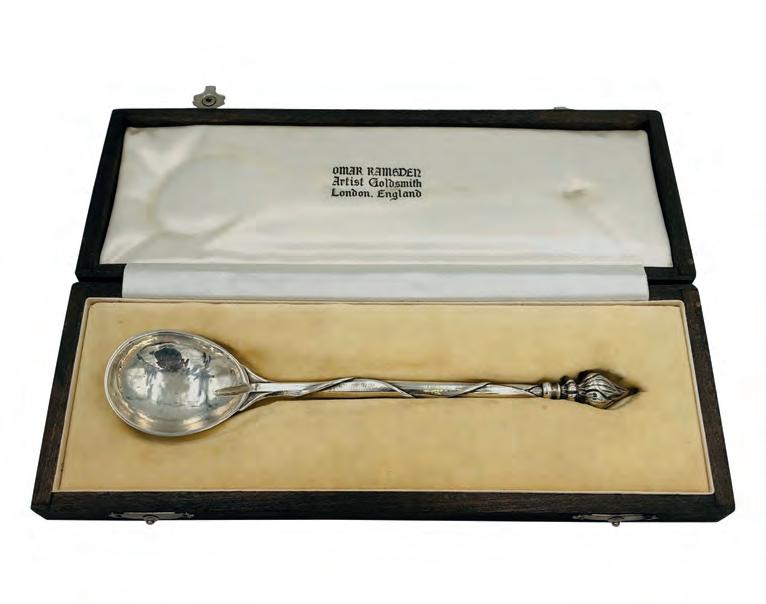
Shining STAR
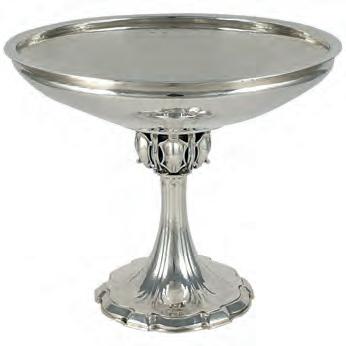
Works by silversmith Omar Ramsden are highly collectable, with pieces by the arts and crafts designer regularly selling for thousands
Born in Sheffield in 1873, Omar Ramsden’s relatively humble beginnings belied the glittering mark he was to leave on the silver industry and the arts and crafts movement. Ramsden’s father, Benjamin Woolhouse Ramsden, ran a silversmith business so from a young age his son was immersed in the craft. Following a brief period of emigration to America, the family returned to Sheffield where Ramsden was apprenticed to a firm of silversmiths in the city. He also enrolled in evening classes at the Sheffield School of Art, a leading centre for art and design.
Above Silver spoon in fitted case, by Omar Ramsden, priced £1,500, www.1stdibs.com
Above right Arts & crafts sterling silver tazza by Omar Ramsden, 1926, priced £3,650, www.1stdibs.com
Below left Omar Ramsden arts & crafts silver and enamel box, 1926, priced £11,075, www.1stdibs.com. Omar Ramsden caskets are very commercial. The most sought after being those with enamel decoration. The enamelling is often done by Jeanne Eteve, previously employed as Ramsden’s secretary

PARTNERS IN SHINE
The classes allowed the budding designer to explore the history of art, becoming influenced by early Celtic compositions and the designs of the Tudors, which were to be recurring themes throughout his career. Ramsden also formed a friendship with fellow student, Alwyn C E Carr, with whom he was to enjoy a highly fertile professional collaboration. The pair both won scholarships to study full time at the school, and also undertook various trips to London and further afield into Europe, visiting numerous galleries and exhibitions.
MACE RACE
Around this period, Ramsden won a competition arranged by the Duke of Norfolk to design a ceremonial mace for the city of Sheffield. Achieving such a prestigious commission immediately raised his profile in the design world and laid the foundations for his burgeoning career.
While undertaking such an honourable and illustrious task for their home city, Ramsden and Carr took the somewhat surprising decision to set up a workshop far from Sheffield, settling in Stamford Bridge Studios in Chelsea, west London. Here, the pair could take advantage of the forward-thinking cultural milieu of the capital as they set about crafting the item that was eventually completed in 1899.
The mace was an impressive expression of their combined skills, incorporating elements such as handbeaten silver, a resplendent royal crown, organic motifs including oak leaves and acorns, and the two coats of arms of Sheffield and the Duke of Norfolk. On the base was an inscription: Deo Adjuvante Labor Proficit (With God’s help our labour is successful), alongside another: Omar Ramsden and Alwyn C E Carr made me in the year of our Lord 1899.
ARTS & CRAFTS
In the same period, Ramsden and Carr also produced other objects that demonstrated their design sympathy with the arts & crafts movement and its graceful and sinuous lines that draw inspiration from the natural world. Their pieces were soon in demand from a modern audience keen to shake off the strict sensibilities of the receding Victorian era.
A move to a new studio and workshop, St Dunstan’s in Fulham, saw the enterprise continue to flourish, with numerous commissions from civil and various other organisations, alongside private clients. Throughout the period of their partnership, which lasted from 1898 to 1915, a wide range of silverware was produced, from smaller pieces of tableware such as spoons and wine coasters, to ornamental centrepieces and larger-scale ecclesiastical silver. The decoration of many of these objects showcased their predilection for designs of
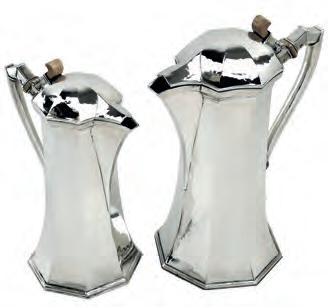
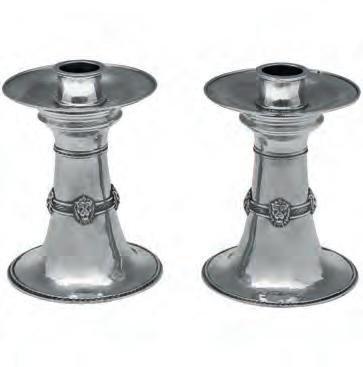
earlier epochs, such as the medieval, Tudor and gothic periods, while fully embracing the arts and crafts ethos. Ramsden and Carr’s highly productive partnership continued up until WWI when the latter enlisted with the Artist’s Rifles and left for France. Ramsden remained in London, eventually heading a team of some 20 silversmiths at the workshop he continued to run until his death in 1939.

RAMSDEN MARKS
The marks found on items made by Omar Ramsden reflect the two different periods of his creative output, both in partnership with Carr and then on his own.
The first mark registered by the pair in February 1898 features the letters ‘RN & CR’. Despite the partnership effectively ending with Carr’s wartime service, the mark was last used in 1919. From 1917 until 1938, the year before Ramsden passed away, the firm’s registered silver mark was ‘O R’. Items produced during this time also mostly feature the Latin inscription: ‘Omar Ramsden Me Fecit’ (‘Omar Ramsden Made Me’). In order to achieve the greatest value, the marks on pieces of Omar Ramsden silverware need to be in perfect condition and clearly defined.

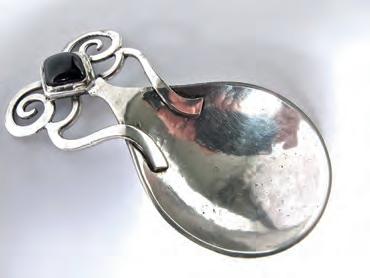
Above left A pair of Omar Ramsden arts & crafts sterling silver ewers, priced £15,500, www.1stdibs.com
Above A pair of arts & crafts sterling silver candlesticks by Omar Ramsden, priced £6,275, www.1stdibs.com
Below left Examples of Omar Ramsden’s mark, including the inscription Omar Ramsden Me Fecit (Omar Ramsden Made Me), image courtesy of AC Silver
Did you know?
In the aftermath of WWI, Ramsden created various war memorials for sites across the UK. These include memorials to members of the London hop trade (adjacent to the Southwark war memorial); the Mayfield war memorial in East Sussex and a bronze of St George and the Dragon, depicted on the memorial at Sandwich in Kent.
IN DEMAND
Demand for silverware by Omar Ramsden and CE Carr is currently robust, with prices at auction and in the marketplace reflecting its continuing appeal.
A George V Omar Ramsden silver dish, sold at Elstob & Elstob for £1,700
At Yorkshire auctioneers Elstob & Elstob, a George V silver dish hallmarked 1921 in a planished navette shape with pierced foliate berry ends sold for £1,700. Auctioneer David Elstob commented: “Demand is there for Ramsden, we have sold a number of pieces during the last 18 months and rarely fail.”
Elsewhere, a pair of George V silver sauceboats marked London 1912 sold at Tennants Auctioneers’ jewellery watches and silver sale last March for £1,200. The sauceboats were possibly part of a service commissioned between 1906 and 1922 by Martin de German-Ribon OBE.
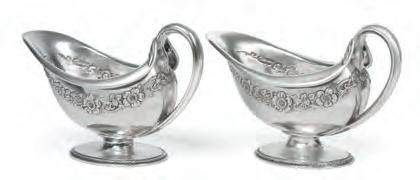
The sauceboats were possibly part of a full dinner service, which sold at Tennants Auctioneers
Perhaps some of the most sought-after, entry-level items crafted by Ramsden are his spoons. These are large in number, with caddy spoons being particularly popular with collectors. Typically, Ramsden caddy spoons feature a Celtic-style knop which can be set with cabochons. While prices for a single arts & crafts spoon by Ramsden start at around £200£300, this can rise to £3,000 for a caddy spoon in perfect condition.
Above Of all the spoons made by Ramsden the caddy spoon is the most sought after, image courtesy of 1st Dibs

